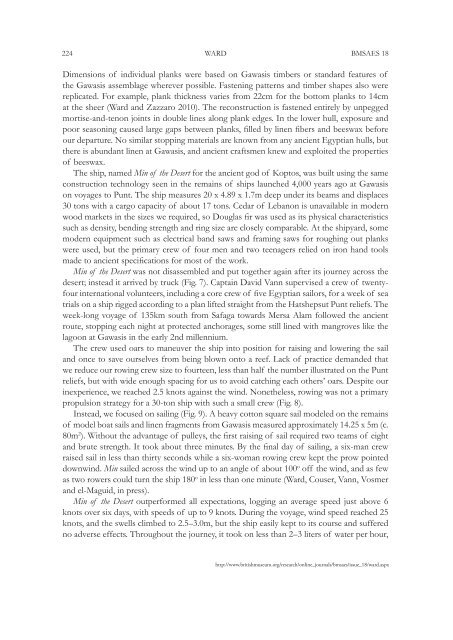Building pharaoh's ships: Cedar, incense and ... - British Museum
Building pharaoh's ships: Cedar, incense and ... - British Museum
Building pharaoh's ships: Cedar, incense and ... - British Museum
Create successful ePaper yourself
Turn your PDF publications into a flip-book with our unique Google optimized e-Paper software.
224<br />
WARD BMSAES 18<br />
Dimensions of individual planks were based on Gawasis timbers or st<strong>and</strong>ard features of<br />
the Gawasis assemblage wherever possible. Fastening patterns <strong>and</strong> timber shapes also were<br />
replicated. For example, plank thickness varies from 22cm for the bottom planks to 14cm<br />
at the sheer (Ward <strong>and</strong> Zazzaro 2010). The reconstruction is fastened entirely by unpegged<br />
mortise-<strong>and</strong>-tenon joints in double lines along plank edges. In the lower hull, exposure <strong>and</strong><br />
poor seasoning caused large gaps between planks, filled by linen fibers <strong>and</strong> beeswax before<br />
our departure. No similar stopping materials are known from any ancient Egyptian hulls, but<br />
there is abundant linen at Gawasis, <strong>and</strong> ancient craftsmen knew <strong>and</strong> exploited the properties<br />
of beeswax.<br />
The ship, named Min of the Desert for the ancient god of Koptos, was built using the same<br />
construction technology seen in the remains of <strong>ships</strong> launched 4,000 years ago at Gawasis<br />
on voyages to Punt. The ship measures 20 x 4.89 x 1.7m deep under its beams <strong>and</strong> displaces<br />
30 tons with a cargo capacity of about 17 tons. <strong>Cedar</strong> of Lebanon is unavailable in modern<br />
wood markets in the sizes we required, so Douglas fir was used as its physical characteristics<br />
such as density, bending strength <strong>and</strong> ring size are closely comparable. At the shipyard, some<br />
modern equipment such as electrical b<strong>and</strong> saws <strong>and</strong> framing saws for roughing out planks<br />
were used, but the primary crew of four men <strong>and</strong> two teenagers relied on iron h<strong>and</strong> tools<br />
made to ancient specifications for most of the work.<br />
Min of the Desert was not disassembled <strong>and</strong> put together again after its journey across the<br />
desert; instead it arrived by truck (Fig. 7). Captain David Vann supervised a crew of twentyfour<br />
international volunteers, including a core crew of five Egyptian sailors, for a week of sea<br />
trials on a ship rigged according to a plan lifted straight from the Hatshepsut Punt reliefs. The<br />
week-long voyage of 135km south from Safaga towards Mersa Alam followed the ancient<br />
route, stopping each night at protected anchorages, some still lined with mangroves like the<br />
lagoon at Gawasis in the early 2nd millennium.<br />
The crew used oars to maneuver the ship into position for raising <strong>and</strong> lowering the sail<br />
<strong>and</strong> once to save ourselves from being blown onto a reef. Lack of practice dem<strong>and</strong>ed that<br />
we reduce our rowing crew size to fourteen, less than half the number illustrated on the Punt<br />
reliefs, but with wide enough spacing for us to avoid catching each others’ oars. Despite our<br />
inexperience, we reached 2.5 knots against the wind. Nonetheless, rowing was not a primary<br />
propulsion strategy for a 30-ton ship with such a small crew (Fig. 8).<br />
Instead, we focused on sailing (Fig. 9). A heavy cotton square sail modeled on the remains<br />
of model boat sails <strong>and</strong> linen fragments from Gawasis measured approximately 14.25 x 5m (c.<br />
80m 2 ). Without the advantage of pulleys, the first raising of sail required two teams of eight<br />
<strong>and</strong> brute strength. It took about three minutes. By the final day of sailing, a six-man crew<br />
raised sail in less than thirty seconds while a six-woman rowing crew kept the prow pointed<br />
downwind. Min sailed across the wind up to an angle of about 100 o off the wind, <strong>and</strong> as few<br />
as two rowers could turn the ship 180 o in less than one minute (Ward, Couser, Vann, Vosmer<br />
<strong>and</strong> el-Maguid, in press).<br />
Min of the Desert outperformed all expectations, logging an average speed just above 6<br />
knots over six days, with speeds of up to 9 knots. During the voyage, wind speed reached 25<br />
knots, <strong>and</strong> the swells climbed to 2.5–3.0m, but the ship easily kept to its course <strong>and</strong> suffered<br />
no adverse effects. Throughout the journey, it took on less than 2–3 liters of water per hour,<br />
http://www.britishmuseum.org/research/online_journals/bmsaes/issue_18/ward.aspx
















